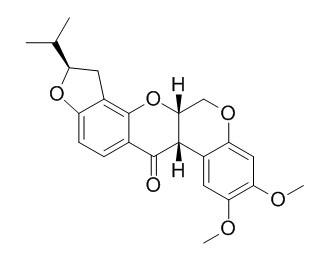Dihydrorotenone
Dihydrorotenone is a potent mitochondrial inhibitor and probably induces Parkinsonian syndrome. It induces human plasma cell apoptosis by provoking endoplasmic reticulum stress and induces cell death by activating the p38 but not the JNK signaling pathway.
Inquire / Order:
manager@chemfaces.com
Technical Inquiries:
service@chemfaces.com
Tel:
+86-27-84237783
Fax:
+86-27-84254680
Address:
1 Building, No. 83, CheCheng Rd., Wuhan Economic and Technological Development Zone, Wuhan, Hubei 430056, PRC
Providing storage is as stated on the product vial and the vial is kept tightly sealed, the product can be stored for up to
24 months(2-8C).
Wherever possible, you should prepare and use solutions on the same day. However, if you need to make up stock solutions in advance, we recommend that you store the solution as aliquots in tightly sealed vials at -20C. Generally, these will be useable for up to two weeks. Before use, and prior to opening the vial we recommend that you allow your product to equilibrate to room temperature for at least 1 hour.
Need more advice on solubility, usage and handling? Please email to: service@chemfaces.com
The packaging of the product may have turned upside down during transportation, resulting in the natural compounds adhering to the neck or cap of the vial. take the vial out of its packaging and gently shake to let the compounds fall to the bottom of the vial. for liquid products, centrifuge at 200-500 RPM to gather the liquid at the bottom of the vial. try to avoid loss or contamination during handling.
Agriculture.2024, 69(3):140-148.
Evid Based Complement Alternat Med.2021, 2021:8707280.
Asian Journal of Chemistry2018, 30(12):2699-2703
Food Chem.2024, 436:137768.
Bioinformatics 2024, 586957
Int. J. Mol. Sci.2022, 23(8), 4130.
Phytomedicine.2018, 40:37-47
Reprod Toxicol.2020, 96:1-10.
JMicrobiol Biotech Food Sci2021, e4289.
Nutrients.2018, 11(1):E17
Related and Featured Products
J Biochem Mol Toxicol. 2014 May;28(5):232-8.
Natural pesticide dihydrorotenone arrests human plasma cancer cells at the G0/G1 phase of the cell cycle.[Pubmed:
24615755]
Dihydrorotenone (DHR) is a natural pesticide used for farming including organic produces. We recently found that Dihydrorotenone induces human plasma cell apoptosis by provoking endoplasmic reticulum stress.
METHODS AND RESULTS:
In the present study, we found that Dihydrorotenone arrested human plasma cancer cells at the G0/G1 phase of the cell cycle. Dihydrorotenone inhibited cyclin D2 transactivation, thus inhibiting its mRNA expression. In addition, Dihydrorotenone upregulated the cell cycle repressors p21 and p53. Dihydrorotenone also increased the phosphorylation level of p53, suggesting the upregulated transactivation function of p53, which was confirmed by the induction of p21, a substrate of activated p53. Moreover, Dihydrorotenone downregulated AKT and ERK phosphorylation, an incentive of cell cycle progression.
CONCLUSIONS:
Therefore, these results collectively demonstrated that Dihydrorotenone disrupts the cell cycle progress, which suggests that Dihydrorotenone is toxic to human plasma cells. Caution is thus suggested when handling with this agent.
PLoS One. 2013 Jul 26;8(7):e69911.
The natural pesticide dihydrorotenone induces human plasma cell apoptosis by triggering endoplasmic reticulum stress and activating p38 signaling pathway.[Pubmed:
23922854]
Dihydrorotenone (DHR) is a natural pesticide widely used in farming industry, such as organic produces. Dihydrorotenone is a potent mitochondrial inhibitor and probably induces Parkinsonian syndrome, however, it is not known whether Dihydrorotenone is toxic to other systems.
METHODS AND RESULTS:
In the present study, we evaluated the cytotoxicity of Dihydrorotenone on human plasma cells. As predicted, Dihydrorotenone impaired mitochondrial function by decreasing mitochondrial membrane potential in plasma cells. Because mito-dysfunction leads to unfolded protein response (UPR) and endoplasmic reticulum (ER) stress, we examined the signature proteins in ER stress, including GRP78, ATF4, and CHOP. After Dihydrorotenone treatment, these proteins were significantly upregulated. It is reported that activation of the mitogen-activated protein kinases p38 and JNK are involved in endoplasmic reticulum stress. However, in the subsequent study, Dihydrorotenone was found to activate p38 but not the JNK signaling. When pre-treated with p38 inhibitor SB203580, activation of p38 and cell apoptosis induced by Dihydrorotenone was partially blocked.
CONCLUSIONS:
Thus, we found that Dihydrorotenoneinduced human plasma cell death by activating the p38 but not the JNK signaling pathway. Because plasma cells are very important in the immune system, this study provided a new insight in the safety evaluation of Dihydrorotenone application.



